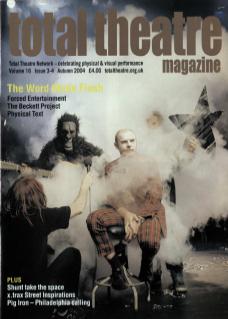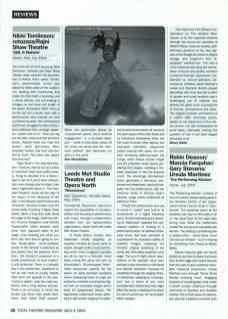The triple bill, Resonance, sets out to explore the possibilities of interdisciplinary work focusing on performance and music, through a collaboration between their two representative organisations, Opera North and Leeds Met Studio Theatre.
In Faulty Optic's Licked, their trademark cronky puppetry, as superbly handled as we've come to expect, brought to life a nocturnal fantasy world where imagined monsters are all too real in a Victorian moral fable mining the same rich vein as Improbable's Shockheaded Peter. Video sequences expertly set the scene: an eerie desolate woodland where endearing tribes of pegs are snared by a sinister hunchbacked figure with an overactive tongue and a taste for gingerbread babies. The ingeniously customised booth allowing for split-screen staging of a table top household remained off-centre to the open space of the dark forest and its monstrous inhabitants. Here, the full-scale bunraku-style figures and stop-start animation sequences played expertly with scale; the children remaining tabletop-sized, the hungry witch always human height and the projected world exactly paralleling that staged, creating a fantastic extension to the live physical world. The broodingly atmospheric score, grounded in tremulous xylophone and vibraphone, was built integrally into the performance, with the histrionic tones of Dominic Sale's fairytale songs archly performed by Katharine Price.
If both the performance and use of sound in Licked were built in as components of a highly theatrical piece, Forced Entertainment's reworking of Starfucker explored the conceptual addition of scoring to a performance piece. An abstract three-voice score had been provided to counterpoint its evocative series of celebrity images, replacing Tim Etchells' original rendering of the words with their video projection onto stage. The sort of ‘high culture' associations of the operatic voice were perhaps a nice comment on the banal and absurd situations imposed on celebrities through the staging (‘Antonio Banderas, weeping on a trampoline') but in terms of any more correspondent relationship that might affect the sense or feeling of the piece the use of sound was, for me at least, rather opaque.
Paul Clark and John Binias' collaboration on The Weather Man moved us to the opposite extreme through the sound-led narrative of Robert Fitzroy, insecure idealist, philanthropic governor of Fiji, sea captain of the Beagle for Darwin's fateful voyage, and England's first, ill-equipped 'weatherman'. This was a richly historical tale using the interrelation of sound and spoken narrative to explore thematic oppositions: creationism vs. natural selection; discursive vs, narrative. Sarah Belcher's varied and dramatic libretto played beautifully with tone and the conflict of spoken and sung narration was a challenging use of material and allowed for great aural counterpoint of themes, atmospheres and ideas. The staging however, reminiscent of a 1960s BBC recording studio, played on the dated tone of the written source, but also emphasised its aural basis, ultimately inviting the question of why it had been staged physically at all.

